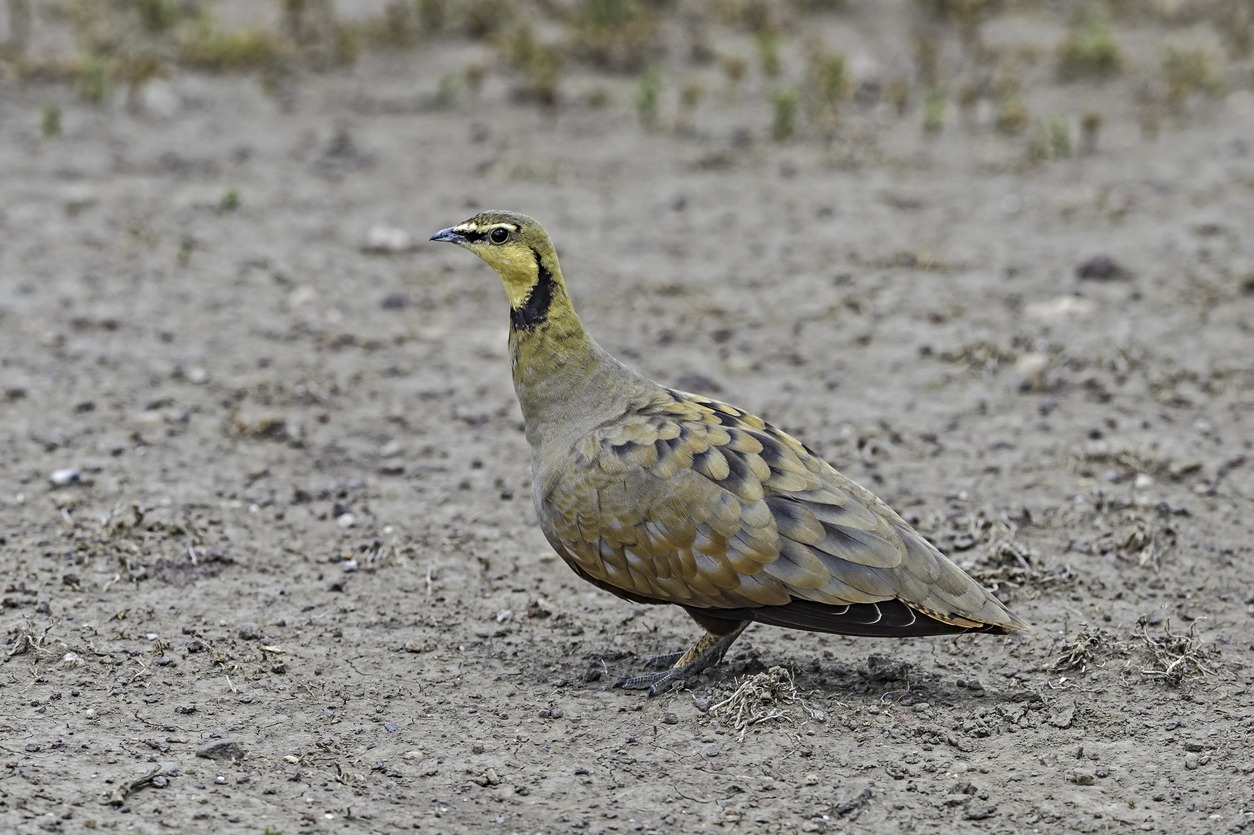It is a stubby, short-legged bird that resembles a pigeon, hobbling oddly on the ground yet is swift and direct when in flight. They have a buff-yellow throat and chin, in which they derived their name. Pairs or small groups of these birds occur in farmlands, grassland, and savanna in middle altitudes, lurking away from arid areas. They are known for their deep, loud, and guttural “ke-rek ke-korr-ow” call.
What is a Yellow-throated Sandgrouse?
Yellow-throated Sandgrouses (Pterocles gutturalis) is a species of birds coming from the Pteroclididae family. They are found in many African countries and are relatively larger than its sandgrouse cousins in its range.
These birds are swift and tenacious flyers. They often occur in large flocks, up to 80 birds when they are drinking, and up to 400 birds when they are feeding.
Its seven levels of classification are as follows:
Kingdom: Animalia
Phylum: Chordata
Class: Aves
Order: Passeriformes
Order: Pterocliformes
Family: Pteroclidae
Genus: Pterocles
Species: P. gutturalis
Yellow-throated Sandgrouse Physical Description
Yellow-throated sandgrouses have an average head to tail length of around 12 inches to 15 inches or 33 to 40 centimeters, and an average weight of 150 to 500 grams. Females and males look similar, though males are quite large. Males and females look alike, except the males are slightly larger. They are short-legged, which has feathers down to the toes.
Yellow-throated sandgrouse males boast a yellow-throat with black edgings, in which the species derived its common name. The males also have an olive-brown plumage, dark upperparts, accentuated by reddish breast and wings. Meanwhile, females have a streaked plumage, mottled with black and buff marks. Plus, she has a yellowish-brown throat and face.
Both sexes also possess a black lining across the eye up to the beak. Compared to other sandgrouses, they have darker underparts.
Where can they be spotted?
Yellow-throated sandgrouses thrive in open grasslands with moist soils, such as near rivers, flood plains, or swamps. They may also occur in cultivated lands or fallow fields.
They can be found in African countries, such as Kenya, Zambia, Ethiopia, Tanzania, and southern Africa. They are quite uncommon in parts of western Zimbabwe, northern Botswana, northern Namibia, and south-western of the Limpopo province.
While they are common residents in their chosen habitats, these can be breeding visitors to southern Zambia during the dry, arid season.
Interesting Facts You Should Know About the Yellow-throated Sandgrouse
Yellow-throat sandgrouses are herbivores and feed on various types of seeds, especially legumes. Other types of seeds that it consumes include Cassia, Sesbania, Amaranthus, Hibiscus, Helianthus, and Indigofera. These birds also eat commercial crops, such as wheat, oats, barley and soya beans.
These birds are solitary nesters, which means nests are situated at least a hundred meters apart. Their nest is usually a shallow depression on the ground, typically lined with weed stems and grass, situated under or across a shrub.
Yellow-throat sandgrouses are monogamous and form life-long bonds with their partners. Their egg-laying season occurs during the dry winter months, from March to October, which peaks from April to August.
The female lays 2-3 eggs, which the parents both incubate for around 25-26 days. The female incubates the eggs during the day, while the male takes over at night until the early mornings.
Once the eggs hatch, the chicks are jointly cared for by the parents. The female usually brings them water through her soaked belly feathers. Chicks can feed themselves soon but may need several months to learn foraging techniques from their parents. They will be under parental care until they become independent.
Yellow-throated sandgrouses are not threatened worldwide. However, they are near-threatened in South Africa, as their species is uncommon in protected regions, and their populations usually settle on croplands. That means that their number depends much on how agricultural systems and practices change in the future.
WILDLIFE PARKS AND RESERVES WHERE THIS SPECIES IS FOUND:
BOTSWANA
ZIMBABWE
ZAMBIA
BOTSWANA BIRDS | SOUTH AFRICA BIRDS
NAMIBIA BIRDS | ZAMBIA BIRDS | ZIMBABWE BIRDS
